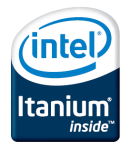After spending quite some money buying an SGI Octane, a Sun Blade 100, a rather powerful and at the same time useless IBM 9114-275, and lastly a PowerMac G5, I've come to the conclusion that x86 can't be beat for desktop use.
In retrospect, that might seem like a really dumb and obvious statement. But I think it's finally gotten me over this "halo" that computers with RISCky ISAs will work wonders for me. They don't. Actually, they just sit around looking cool, and the SGI Octane in particular is a great conversation piece, although it seems like it's losing out to the PoweMac G5. One thing's for sure - they're very reliable considering their age.
First there's the price/performance ratio. Well, actually the price performance ratio doesn't matter to me that much since I do have a soft spot for these babies still. But I'll just note that I've spent enough on all this hardware that I could buy myself a new x64 computer that would run circles around any one of these. That's true for any old computer - the only exception to this is a used Mac Pro, but I'll get to that in a moment.
My typical use for the machines goes like this - I run Firefox, a terminal, sshd, play music in at least several different formats (SPC/PSF, WavPack, FLAC, APE, Musepack, Vorbis, MP3, AAC, SHN, TTA and I even have the occasional MP2 file), play anime HDTV rips, uTorrent, and I generally keep all these open at the same time. I generally go out of my way to find something for the computer to do. In the case of the Octane, Blender was an excuse to do something cool with it - Maya was just scary. It looked like C4D, but was nowhere as intuitive. Occasionally I even manage to compile code with MIPSPro, getting something useful out of it. Bottom line, I'm still looking for some use for it.
In the case of the Blade 100, it was supposed to be an unobtrusive file server. That fell through because I'd have to buy a SATA card for it and run Linux, defeating the purpose of getting a SPARC, and I'd need a gigabit ethernet card. No file server supports 137GB maximum on a hard drive. Plus the fan that came with it was rather loud, and on top of that it crashed every now and then. I searched online and found that the error, which only gets sent out via the serial port, was some general umbrella term for god knows what's actually happening. I don't have the time and patience to troubleshoot that, plus my Octane's sitting on top of it.
The 9114-275 had enough power to be a desktop machine, but it just didn't have the software to do so. That was really unfortunate, and I think that's why I was really disappointed with it. To use it as a desktop, you need Linux. Take it from me, AIX as a desktop sucks. You should think of AIX's X11 as something that exists solely to let CATIA run on it. But you need to use this machine with '95 era graphics cards if you want good support. Everything faster than a Radeon 7000 is a hack. And it was terribly loud, and the sound card is of the lowest quality possible. As a person who keeps his music playing whenever he's awake, that's a definite no. I think it'd do well as a server, since it's powerful and has plenty of RAM and integrated gigabit, plus LPARs and WPARs are cool. I don't know much about what IBM's customers use their POWER CPUs for, but it's probably not LAMP.
The PowerMac G5 has quickly supplanted my laptop as my desktop. It can never be the main machine, since it can't run foobar2000, but it's quiet, takes large hard drives (I'll definitely set this up as some file server once I get the $ for HDDs), is still RISCky, and as a bonus, runs OS X and has all the perks of a desktop OS. I think I've come to ask a lot of it, much more than what I expected out of the Octane/9114-275, and so far it's done all that admirably, except for foobar2000's incredible tag management - I have to use my Windows 7 laptop for converting the codepage within music tags, for instance, and keeping the filenames in a certain scheme. It plays 720p well, barely manages to keep up with 1080p with a custom compiled mplayer+ffmpeg-mt, but that's not a big problem. The big problem is that it can play 1080p, but barely manages to do so. I can't stand that - I want it to play smoothly, or not play it at all! A dual 2.3-2.7GHz G5 would probably be able to play 1080p smoothly.
That was when I thought to myself: if I had a thousand bucks, I'd get a used Mac Pro, use OS X for everything, and WINE foobar2000. And then it hit me - I had spent the equivalent of a new computer touring around the world of RISC, only to come back to square one of x86. I felt a bit of regret, but then I was happy that I had taken this path. It really is a sinkhole for money, although not as much as being an Apple fanboy. I know a lot more about computers in general, and have a lot more experience with UNIX, which will hopefully this Wednesday get me a job.
In retrospect, that might seem like a really dumb and obvious statement. But I think it's finally gotten me over this "halo" that computers with RISCky ISAs will work wonders for me. They don't. Actually, they just sit around looking cool, and the SGI Octane in particular is a great conversation piece, although it seems like it's losing out to the PoweMac G5. One thing's for sure - they're very reliable considering their age.
First there's the price/performance ratio. Well, actually the price performance ratio doesn't matter to me that much since I do have a soft spot for these babies still. But I'll just note that I've spent enough on all this hardware that I could buy myself a new x64 computer that would run circles around any one of these. That's true for any old computer - the only exception to this is a used Mac Pro, but I'll get to that in a moment.
My typical use for the machines goes like this - I run Firefox, a terminal, sshd, play music in at least several different formats (SPC/PSF, WavPack, FLAC, APE, Musepack, Vorbis, MP3, AAC, SHN, TTA and I even have the occasional MP2 file), play anime HDTV rips, uTorrent, and I generally keep all these open at the same time. I generally go out of my way to find something for the computer to do. In the case of the Octane, Blender was an excuse to do something cool with it - Maya was just scary. It looked like C4D, but was nowhere as intuitive. Occasionally I even manage to compile code with MIPSPro, getting something useful out of it. Bottom line, I'm still looking for some use for it.
In the case of the Blade 100, it was supposed to be an unobtrusive file server. That fell through because I'd have to buy a SATA card for it and run Linux, defeating the purpose of getting a SPARC, and I'd need a gigabit ethernet card. No file server supports 137GB maximum on a hard drive. Plus the fan that came with it was rather loud, and on top of that it crashed every now and then. I searched online and found that the error, which only gets sent out via the serial port, was some general umbrella term for god knows what's actually happening. I don't have the time and patience to troubleshoot that, plus my Octane's sitting on top of it.
The 9114-275 had enough power to be a desktop machine, but it just didn't have the software to do so. That was really unfortunate, and I think that's why I was really disappointed with it. To use it as a desktop, you need Linux. Take it from me, AIX as a desktop sucks. You should think of AIX's X11 as something that exists solely to let CATIA run on it. But you need to use this machine with '95 era graphics cards if you want good support. Everything faster than a Radeon 7000 is a hack. And it was terribly loud, and the sound card is of the lowest quality possible. As a person who keeps his music playing whenever he's awake, that's a definite no. I think it'd do well as a server, since it's powerful and has plenty of RAM and integrated gigabit, plus LPARs and WPARs are cool. I don't know much about what IBM's customers use their POWER CPUs for, but it's probably not LAMP.
The PowerMac G5 has quickly supplanted my laptop as my desktop. It can never be the main machine, since it can't run foobar2000, but it's quiet, takes large hard drives (I'll definitely set this up as some file server once I get the $ for HDDs), is still RISCky, and as a bonus, runs OS X and has all the perks of a desktop OS. I think I've come to ask a lot of it, much more than what I expected out of the Octane/9114-275, and so far it's done all that admirably, except for foobar2000's incredible tag management - I have to use my Windows 7 laptop for converting the codepage within music tags, for instance, and keeping the filenames in a certain scheme. It plays 720p well, barely manages to keep up with 1080p with a custom compiled mplayer+ffmpeg-mt, but that's not a big problem. The big problem is that it can play 1080p, but barely manages to do so. I can't stand that - I want it to play smoothly, or not play it at all! A dual 2.3-2.7GHz G5 would probably be able to play 1080p smoothly.
That was when I thought to myself: if I had a thousand bucks, I'd get a used Mac Pro, use OS X for everything, and WINE foobar2000. And then it hit me - I had spent the equivalent of a new computer touring around the world of RISC, only to come back to square one of x86. I felt a bit of regret, but then I was happy that I had taken this path. It really is a sinkhole for money, although not as much as being an Apple fanboy. I know a lot more about computers in general, and have a lot more experience with UNIX, which will hopefully this Wednesday get me a job.
Originally Posted by Tommie
Please delete your post. It is an insult to all the hard work society has put into making you an intelligent being.
Like somebody at AMD said about a decade ago: Benchmarking is like sex. Everybody brags about it, everybody loves doing it and nobody can agree on performance.
Please delete your post. It is an insult to all the hard work society has put into making you an intelligent being.
Like somebody at AMD said about a decade ago: Benchmarking is like sex. Everybody brags about it, everybody loves doing it and nobody can agree on performance.

 <>
<>


 It's surprising to hear the SH is in Nikon cameras. Great, now I have to have a Nikon camera too.
It's surprising to hear the SH is in Nikon cameras. Great, now I have to have a Nikon camera too.
 Extreme R4400 200MHz (1MB L2) 160MB
Extreme R4400 200MHz (1MB L2) 160MB






 (single-CM)
(single-CM)





